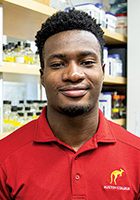Spreading its Wings
By Cary S. Wacker
Words like develop, discover, and explore are embedded in the lexicon of learning at Austin College, and they are powerfully exemplified within the Center for Research, Experiential, Artistic, and Transformative Education. Five years on since its founding, CREATE has supported one of every three graduating students in directed research and creative scholarship, and fostered a remarkable 130,000 hours of research time by students across every major offered at Austin College.


hen Biology Professor Dr. Lance Barton, CREATE’s Director, launched the center in 2015, his vision was to build a community around hands-on, active research in which undergraduate students are fully engaged in knowledge creation to seek solutions to research problems.
Today, CREATE is thriving as the campus nerve center for students pursuing deep, transformative, scholarly engagement within their respective disciplines, as well as those creating original works in the Humanities. Barton, now the holder of the Richardson Chair for CREATE, leads the center’s efforts to support intellectual opportunities, including the Departmental Honors program—the senior thesis program for top students—and summer research. The center also sponsors the annual Austin College Student Scholarship Conference (ACSC), a multi-day showcase of professional-level presentations by students sharing their research and creative work. Each year’s event involves over 160 students and provides a dynamic platform for presenting novel scholarship to peers and faculty.
Since 2015, a total of 519 students have engaged in formal research, creative scholarship, or artistic presentations. The participants’ diversity almost perfectly mirrors the demographics of the student body: 48% were students of color and 32% were among those with high financial need. CREATE is opening a path for any talented student to be guided and encouraged in creative, scholarly efforts, and a high percentage of CREATE alumni continue to post-graduate programs that further their interest in research and professional development.
With impressive statistics rolling in and the impact on student outcomes ever growing, Barton shared some thoughts on the metamorphosis of CREATE. His comments reflect the ongoing commitment on campus to empower Austin College students to take flight.
 How has CREATE evolved since its beginning?
How has CREATE evolved since its beginning?
“I think the biggest items have been recognition and collaboration. I feel like the faculty, students, and campus offices know CREATE and work with us; consequently, the program is really starting to develop effectively. Student research touches on so many aspects of what we do well as an institution, and partnerships with our Johnson Center [for Faculty Development], Scarbrough Writing Center, Career Services, and others have been effective in helping CREATE build the outreach on campus. I must also say that CREATE has a great steering committee and program coordinators that have enabled the campus to work cohesively around a common set of values. This is reflected in small tweaks to campus programs that bring everyone to a new level of excellence. Our work is not complete, but we have shared our ideas and practices, learned from each other, and have advanced the program with shared ideas.”
What do you consider most distinctive about CREATE?
“Honestly, that is a hard question. I learn a lot from my colleagues at other colleges and universities around the country, and we share numerous ideas. The kinds of programs that we offer are similar, but what stands out to me about what CREATE does well is that it engages a diverse set of students. We have been paying attention and asking questions about inclusion from the beginning. Our goals have often focused on removing barriers to participation. We’ve always worked with students and faculty to integrate new ideas and forms of intellectual scholarship and creative activities instead of forcing a particular model. This emphasis on inclusion and support has helped broaden the quantity and quality of opportunities associated with CREATE.”
What do you think is attractive/motivating to students who are part of CREATE?
“Each student has a unique story; at the same time, I’d like to think that when students engage in research and creative activities that they do it to learn, to learn how to learn, to engage with faculty in meaningful ways, to discover something new, maybe something new about themselves, and to be a part of a community of scholars and researchers. As we have heard time and again, while this process can be fulfilling, it can also be difficult and at times isolating, as a student engages deeply with the project. I hope that CREATE provides value to those students by building community, providing opportunities to feel connected, and helping faculty to mentor students effectively and productively. For both faculty and students who are part of CREATE, we want to affirm that their work is valued by more than just themselves and empower them to achieve great things.”
Throughout the academic year, CREATE faculty members provide guidance for all stages of the research process, and every faculty member is impacted by students’ participation.






